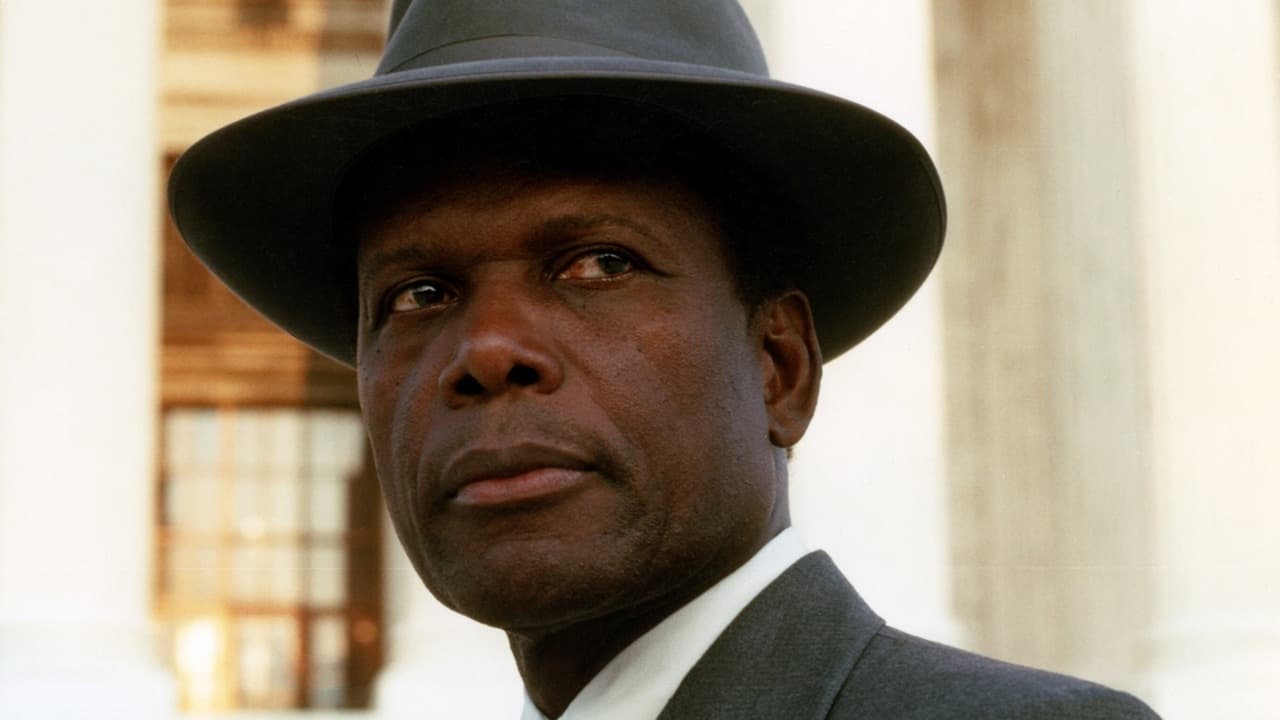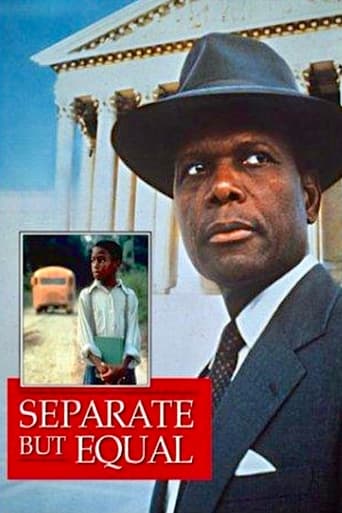

The main goal of this movie is to inform about the background and internal Supreme Court argumentation in the "Brown vs. Board of Education of Topeka, Kansas" case. It is a dramatized interpretation and, given that, I was left wondering just what was fact and what was speculation. Given the importance of the case, I assume that the major courtroom arguments were taken from court transcripts, but clearly there is a fair amount of speculation. For example, who really knows what conversations went on among the Supreme Court justices in their arriving at a unanimous decision? Be that as it may, I found that part of the movie most interesting, particularly at this time when Obergefell v. Hodges (the case for gay marriage) is before the Supreme Court, with a decision to come this month. The Obergefell case has many similarities to the Brown case in that it devolves into a morally right vs. strict interpretation of the law case. There clearly isn't anything in the U.S. Constitution specifically addressing the gay marriage issue (I doubt that homosexuality was even ever discussed when the U.S. Constitution was written). Also, the social repercussions would be major if Obergefell were decided in favor of the plaintiffs. If he were so inclined, I doubt that Chief Justice Roberts would ever get a unanimous decision out of the current court--Justice Scalia would never vote in favor of it, as Justice Reed (of a similar mindset to Scalia) was finally persuaded to in the Brown case.Back to the movie. The first part of the movie details how horribly blacks were treated at the time (early 1950s). Reverend Delaine, a minister and school teacher in Clarendon County, South Carolina, asks his Superintendent of Schools for bus service for his students so that they don't have to walk miles to school. Several times we are shown school buses transporting white kids that buzz right past a black kid walking to school. Delaine's request is denied with the promise that things will get better. Delaine gets some of the parents to file a lawsuit and Thurgood Marshall (Sidney Poitier), an NAACP attorney at the time, takes the case on. The movie speculates about arguments among the NAACP staff as to the wisdom of taking the case on, again some very similar considerations are considered as would apply in the Obergefell case: is the case strong enough, is it too soon to try such a case, etc. Also, as in Obergefell, the Brown case was the merging of several cases and this is how the Kansas label came to be on the case, instead of South Carolina. Of course Delaine was a persona non grata among most of the locals for his daring to bring the case; ultimately his house was burned to the ground.Sidney Poitier was an obvious choice to Play Marshall, but I found that he overacted. His pregnant pauses, serious looks, and verbal modulations would be more appropriate for a Shakespearean play. Maybe Poitier was overcome with the seriousness of the event. As John Davis, a lawyer called by the defense to represent the state, Burt Lancaster gives a believable and relaxed performance. The movie gives a good presentation of both sides of the argument. I have seen Brown vs. Board of Education referenced several times but my knowledge stopped at just knowing that it overturned the sanctioned "separate but equal" doctrine dating to the Plessy v. Ferguson case in 1896. It was good to get some idea of the background of the Brown case and some insight into how the Supreme Court operates. I wish the DVD had had documentary extras.
... View MoreThe relatively peaceful correction through the legal process of an age old wrong is the United States of America at its very best. That is in fact what occurred in the landmark Brown vs. Board of Education decision in 1954.Looking back at that case 52 years later the most significant result of that decision was not in our domestic affairs, but in foreign policy. We were engaged in a Cold War at the time where we vying for the moral leadership of the world against the Soviet Union. If we had not put our own house in order, we would never have gotten any kind of support from any third world nations and never would have triumphed in the Cold War. And it was all for want of a school bus. Black kids in rural Clarendon County, South Carolina had to walk miles to their designated school because the whites running the board of education of that county wouldn't give them a bus. That was the start of the lawsuit that eventually found it's way to the United States Supreme Court. I suppose it is fitting that one black icon be playing the part of another in this film. Sidney Poitier is very good as Thurgood Marshall, the attorney for the National Association for the Advancement of Colored People who believed in the case and fought for it. And like the ending of a fairy tale, Thurgood Marshall was appointed to the Supreme Court where he won the case. But that's later on in his life.Burt Lancaster's farewell performance is of John W. Davis, called the lawyer's lawyer by a host of his colleagues and in fact that is the title of a biography about him. From 1911 to 1921 he was in succession, a Congressman from West Virginia, Solicitor General of the United States and our Ambassador to Great Britain. He left public life after that except in 1924 he was chosen after 103 ballots as a compromise Democratic presidential candidate, but lost to Calvin Coolidge. Oddly enough though it was after becoming a losing presidential candidate that Davis gained his greatest reputation as one of our country's leading attorneys. He worked for big corporations and earned some mighty big fees, but he also did a lot of pro bono work as well. Sad, but his association with racial segregation forever tarnished his reputation. Lancaster plays him with restraint and dignity and Burt was just around the age Davis would have been in arguing before the Supreme Court.The third lead in this is Richard Kiley as Chief Justice Earl Warren. Warren, a liberal Republican Governor of California, was appointed to the bench by Dwight Eisenhower while the Court was considering the case. In fact Ike made another appointment of John Marshall Harlan in place of Robert H. Jackson and those two appointments probably won the case for the NAACP. Kiley comes across as the Earl Warren we remember as Chief Justice, a man who brought common sense to his judicial philosophy. Considered probably one of the three greatest whoever held the job as Chief Justice, the USA is still feeling the political and social impact of the many decisions he led the court in rendering.Warren's problem was that he desperately wanted a unanimous court in this landmark decision. Yet there were a few of the Justices for reasons of precedent and their own personal backgrounds who did not want to take this momentous step.The key scene for Kiley is when on a trip with his black chauffeur after a night in a hotel, Kiley goes out and finds the man has slept in his car because he can't find a hotel that will accommodate blacks. It was a defining moment for Earl Warren in real life and Kiley in the film. He knew he was being given a great chance to right a great wrong and stop something evil. The moral impact of segregation was felt by Kiley and by the audience as well.Separate But Equal is a great historical drama which humanizes the players in an American success story.
... View MoreRecently, four states celebrated the 50th anniversary of a 1954 American Supreme Court landmark decision which struck down the long standing "separate but equal" status for racially divided public schools in a finding against public school racial segregation. The case for desegregation was argued by Thurgood Marshall (Poitier) - founder of the NAACP's Legal Defense Fund who later became the first black Supreme Court justice - before nine Supreme Court justices presided over by Chief Justice Earl Warren (Kiley). Though the federal trial represented a collective consideration of trials in the four states (SC, KS, VA, and DW), this 3 hour, 2 part TV miniseries docudrama focuses on the South Carolina case (Briggs et al. v. Elliott et al.) in Part 1 and the Supreme Court trial in Part 2. "Separate but Equal" has little to offer save its historical significance as it dwells mostly on the legal dialectic at work during this benchmark in the genesis of racial equality in America. Good viewing for anyone with a general interest in the history of racial issues in America or a specific interest in the NAACP or the Supreme Court. (B)
... View MoreSeparate but Equal is a great movie depicting the tragedy of the time of racial segregation in schools and the steps which these men from the NAACP took to correct it. The movie has great acting and intense speech emotion but sinks into the wordiness and vocabulary which lawyers and judges use and leaves the audience scratching their heads or reading the dictionary. Nevertheless, the movie has great speeches and facts as well as events suitable in a history-documentary. Great movie to sit by and try to teach yourself to be a lawyer.
... View More